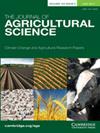盐水灌溉对藜麦水分利用效率的影响在突尼斯的半干旱条件下
IF 1.7
4区 农林科学
Q2 AGRICULTURE, MULTIDISCIPLINARY
引用次数: 0
摘要
本研究于2015年生长季节在突尼斯切尔费赫国家农村工程、水和森林研究所(INRGREF)实验站进行。主要目的是量化和评估不同浓度(T0 = 1.2 dS - m-1, T1 = 9.2 dS - m-1和T2 = 18 dS - m-1)盐水灌溉下藜麦(Chenopodium quinoa Willd.)的耗水量(WC)和水分利用效率。灌溉水含盐量从9.2 dS - m-1增加到18 dS - m-1, TDM从6.7下降到13.4%。T1和T2治疗显著降低了9.8 ~ 12.6%。与对照对照(WUEPR =11.2 kg m-3)相比,T1 (WUEPR = 10.3 kg m-3)和T2 (WUEPR = 9.8 kg m-3)的WUE开花率分别下降了8%和12.5%。灌溉水盐度对花后WUE T0和T1 (WUEPS = 3 kg m-3)无显著影响。然而,T2下降了约15% (WUEPS = 2.5 kg m-3)。收获时,T0下WUETDM最高,为5.43 kg m-3。而WUETDM在T2时最低(5 kg m-3);下降了7.9%。T0时最高WUEGY为2.09 kg m-3。而在T2下,WUEGY的量最小,为1.1 kg m-3。WUEGY由于T2植株高度降低导致产量下降47.4%。本文章由计算机程序翻译,如有差异,请以英文原文为准。
Impact of Saline Water Irrigation (SWI) on Water Use Efficiency of Quinoa (Chenopodium quinoa Willd.) Under Tunisian Semi-arid Conditions
This study was carried out in Cherfech Tunisia, at the experimental station of the National Research Institute of Rural Engineering, Water and Forests (INRGREF) during the growing season 2015. The main objectives are quantifying and valuing the Water consumption (WC) and Water Use Efficiency of quinoa (Chenopodium quinoa Willd.), under saline water irrigation at different concentrations (T0 = 1.2 dS m-1, T1 = 9.2 dS m-1 and T2 = 18 dS m-1). The TDM decreased from 6.7 to 13.4% due to the increase in the salt concentration of the irrigation water from 9.2 to 18 dS m-1. A reduction of 9.8 to 12.6% was marked for treatments T1 and T2. Also, the WUE PR-anthesis has registered a decrease of 8 and 12.5% respectively for T1 (WUEPR = 10.3 kg m-3) and T2 (WUEPR = 9.8 kg m-3) compared with the control T0 (WUEPR =11.2 kg m-3). However, irrigation water salinity showed no effect on the WUE post-anthesis T0 and T1 (WUEPS = 3 kg m-3). Nevertheless, a decrease about 15% was recorded in the T2 (WUEPS = 2.5 kg m-3). At harvest, the highest, WUETDM (5.43 kg m-3) was recorded under T0. However, the lowest WUETDM (5 kg m-3) was marked under T2; a decline of 7.9% was marked. Besides, the uppermost WUEGY (2.09 kg m-3) was recorded under T0. However, the smallest amount of WUEGY (1.1 kg m-3) was recorded under T2. A lessen of 47.4% was manifested on WUEGY due to the height reduction on yield in the T2.
求助全文
通过发布文献求助,成功后即可免费获取论文全文。
去求助
来源期刊

Journal of Agricultural Science
农林科学-农业综合
CiteScore
2.80
自引率
5.00%
发文量
68
审稿时长
1.4 months
期刊介绍:
The Journal of Agricultural Science publishes papers concerned with the advance of agriculture and the use of land resources throughout the world. It publishes original scientific work related to strategic and applied studies in all aspects of agricultural science and exploited species, as well as reviews of scientific topics of current agricultural relevance. Specific topics of interest include (but are not confined to): all aspects of crop and animal physiology, modelling of crop and animal systems, the scientific underpinning of agronomy and husbandry, animal welfare and behaviour, soil science, plant and animal product quality, plant and animal nutrition, engineering solutions, decision support systems, land use, environmental impacts of agriculture and forestry, impacts of climate change, rural biodiversity, experimental design and statistical analysis, and the application of new analytical and study methods (including genetic diversity and molecular biology approaches). The journal also publishes book reviews and letters. Occasional themed issues are published which have recently included centenary reviews, wheat papers and modelling animal systems.
 求助内容:
求助内容: 应助结果提醒方式:
应助结果提醒方式:


